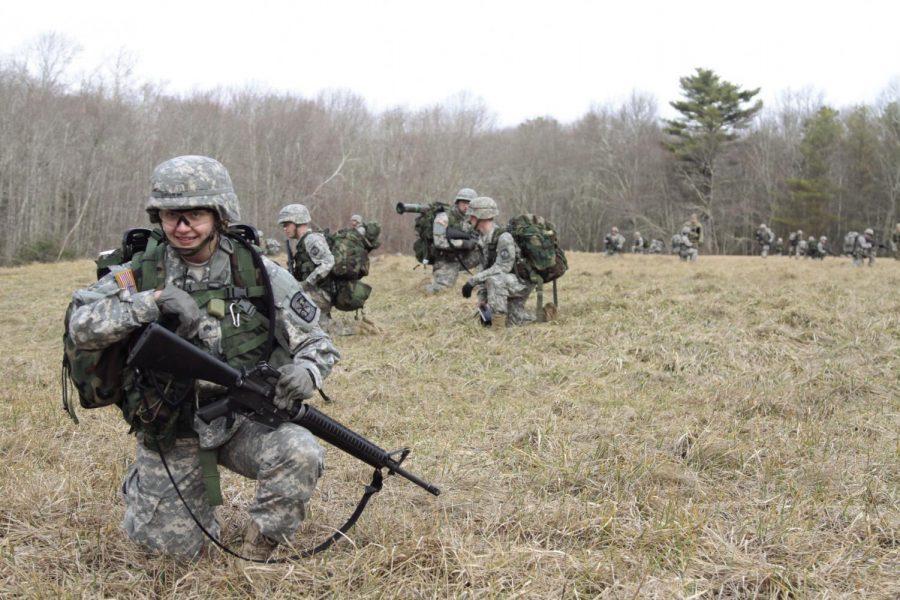Frozen Ram ROTC Operation challenges cadets mentally and physically
Kayla Ebner
Photo Editor
Picture yourself wandering through the woods in the dead of winter with nothing but a vague map and compass to guide you. Oh, and on top of that, you could be ambushed and attacked at any moment. This past weekend members of the Reserve Officer Training Corps at RWU, Salve Regina University, and the University of Rhode Island conducted their annual Frozen Ram military operation alongside members of the National Guard. The exercises they performed were conducted at the URI’s campus along with the Alton Jones Campus in West Greenwich, RI.
Friday night at URI, the cadets performed rehearsals of their formations, conducted a briefing of the operations order, and distributed weapons and MREs (Meals Ready to Eat) to get ready for the long weekend ahead. During this time, Platoon Leaders and Cadre stressed the importance of practicing the proper safety procedures, such as drinking enough water, wearing weather-appropriate clothing, handling weapons properly, and keeping tabs on each other. Cadets were also administered PPE (Personal Protective Equipment) and made sure their rucksacks were equipped with all the gear they would need for the weekend.
Early Saturday morning, the cadets were transported to Alton Jones after spending Friday night at URI. They traveled in LMTV’s driven by members of the National Guard. The cadets and National Guard were distributed into two platoons, or groups, who were declared “enemy forces” against each other. One platoon was acting as the United States army, and the other was Special Forces of the made-up country they were in, called Arania.
Once the cadets were dropped off at the camp, the real fun began. Each platoon walked into the woods in separate directions in search of their first patrol base. The platoon led by Alexis Smith from Salve Regina University reached the first objective in no time. After a break for water, food, and establishing radio contact with the Tactical Operations Center, the journey resumed and the true search for the village began. Walking through the woods to find the village came with several challenges.
Tyler Mobrice, a junior at RWU, was the platoon sergeant for the U.S. forces. He expressed that the hardest part was navigating the route the cadets had planned to get to the village.
“Although we had a map, there is always some differentiation in terrain,” Mobrice said. “The challenge we truly faced was when we were at a halt and we discovered we were around 450 meters closer to the OBJ than we thought. That threw us off as a whole because we were like oh, its right there.”
Behind the scenes, senior cadets at the Tactical Operations Center were calling the shots. The TOC is a small group of specially trained officers who guide, order, and control the cadets in the field on active, tactical missions. They were located in a small building near the end of Alton Jones campus.
Nick George, a senior at RWU, kept radio contact with the U.S. Forces, while fellow RWU senior Jonathan Moore kept radio contact with SPF. Arnaud Vaganay, a senior at RWU, was the Battalion Commander and Andrew Hilton, a senior at URI, was the Battalion Intelligence Officer. Other senior cadets each had their own title, which came with special jobs they were tasked with. At any given moment throughout the weekend, a Major or Cadre could walk in and ask any cadet in the room what was happening. The members at the TOC were expected to have knowledge of everything that was going on at all times.
The main objective for Saturday afternoon was to secure Astara Village, a made-up small town that civilians, played by members of the National Guard, were roaming. This village consisted of a few tents surrounded by three streams and was prime terrain due to its secure location in the woods. This position meant that whichever team got to the village first had the advantage, as the location would allow the occupants of Astara to defend their territory well against the enemy attack. The cadets were told that the civilians may or may not show hostile intent, and were not allowed to shoot at them unless they showed signs of unfriendly behavior.
When the US was close to Astara Village, Cadet Smith sent a small recon group to the outskirts of the village to get a clearer picture of what was going on. The cadets soon realized that the other platoon had gotten there first, and headed back to the rest of the group to figure out a plan of attack. When the team finally came up with a plan, they attacked the village and did not come out on top.
Eli Dias, a junior at Salve Regina University, reflected on his experience positively.
“What is good about events like Frozen Ram is that it is a preview of what we will experience in just a few years when we become Platoon Leaders in the U.S. Army,” said Dias.
After a day of navigating through the woods, the platoons bunkered down and slept outside in the below-freezing temperatures and rain storm. When they awoke the next morning, they returned back to the camp ground and had a nice meal in the dining area after an AAR (After Action Review) lead by Lieutenant Colonel Michael Loftus. The cadets and National Guard members were allowed to speak freely about what they though went right and wrong with their missions.
Eli Dias spoke up several times at the AAR to share his opinion with the battalion.
“I believe the AAR was beneficial because for our leaders, it is an opportunity to recognize what they did right, and where they can improve,” Dias said. “For subordinates, it is a chance to express their opinions on how the training went.”
Overall, the cadets learned some very important lessons from their mission. David Hayes, a freshman at RWU, was honored for his outstanding performance in the field. Hayes was Bravo Team Leader for first squad in the U.S. Platoon and was in charge of three National Guardsmen. He was given an ROTC challenge coin and was recognized by the Colonel in front of both platoons at the AAR.
“I didn’t even think I was going to be called up,” Hayes said. “I was just trying to do my best in my first leadership position in the program.”





